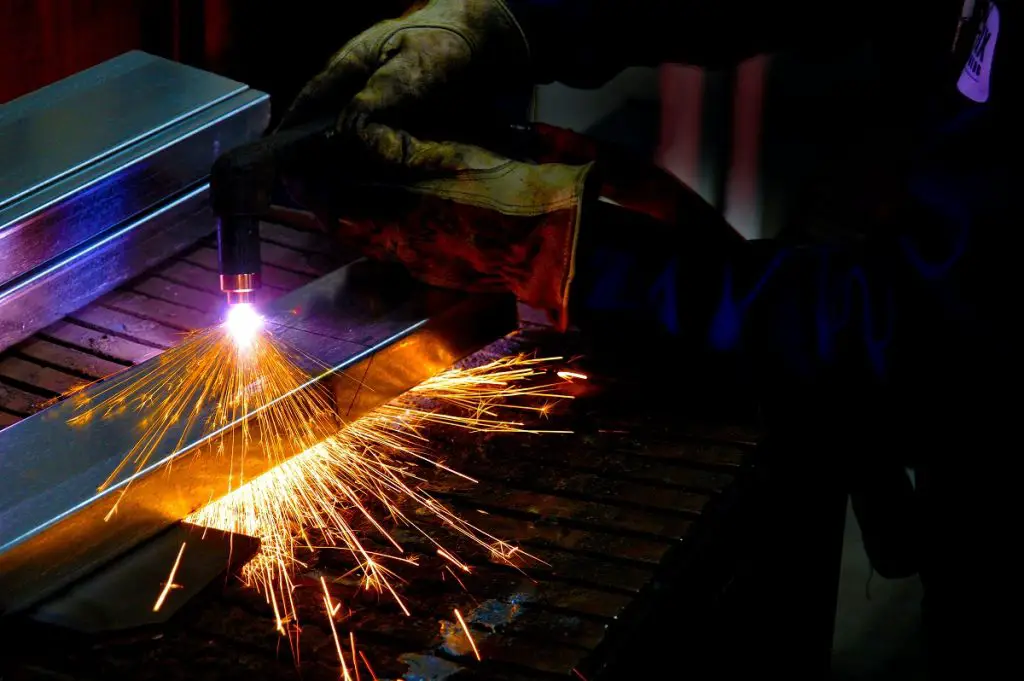Yes, you can weld painted metal, but it’s not recommended. Remove paint before welding to ensure strong, clean welds and prevent toxic fumes. Sanding, grinding, or chemical stripping are effective paint removal methods.
To be confident the weld is as strong as it can be, you will want to ensure all potential impurities have no chance of contaminating your weld, which means removing paint before welding. Your welds will not only be stronger but also look better.
While welding, common impurities are mill scale, dirt, grease, rust, and paint. New steel may come from the mill with an oil coating that protects the steel from rusting until it is put to use.
Table of Contents
Do you need to remove paint from metal before welding?
If you are repairing a broken weld, grind the old weld off completely. Then, remove any paint and clean up the edges, so the mating surfaces fit evenly. This is preferable to trying to weld over the broken area. Your new weld will be stronger and look more professional.

The inhalation of burning paint fumes is dangerous
Your project needs to be free from paint around the welding area for an additional reason. Burning paint generates toxic fumes.
It’s simply too easy to remove the paint before welding to avoid this step. A wire wheel on an angle grinder is a great tool for removing paint.
The wire wheel will also remove any other potential contamination lurking on your base metals. A flap wheel on an angle grinder is also a great choice, as is media blasting.
If a grinding disc is used, refrain from removing too much metal from thin base metals to guarantee that the strength of the metals is not reduced.
After buffing with a wire wheel, acetone may be needed to remove any residual paint. On new steel with an oil coating, clean the oil off with acetone before buffing.
Paint near the weld tends to burn, even after the welding process has stopped.
This could cause additional problems for the welder if, for example, a fire were to go unnoticed under the frame of a trailer that could ignite other flammable materials.
OSHA Regulation 1926.354 for employees.
In enclosed spaces, all surfaces covered with toxic preservatives shall be stripped of all toxic coatings for a distance of at least 4 inches from the area of heat application, or the employees shall be protected by air line respirators, meeting the requirements of Subpart E of this part A.
Toxic preservatives include epoxy and polyurethane paint.
Government regulations usually err on the safe side, but the above regulation may not go far enough. “In enclosed spaces,” may be misleading. I argue that the capacity to inhale toxic fumes is too great to risk even in open-air environments.
How to Remove Paint from Metal
Table grinders, hand-held grinders, buffing wheels and the other tools necessary to remove paint can also be dangerous. For instance, wire wheels for cleaning and buffing will occasionally throw loose wires.
The big, knotted or twisted wire wheel wires are heavy enough that they will penetrate the skin. In addition to pulling a few wires out of my bicep from more than an inch deep, I have seen one penetrate a face shield.
So, it is highly advisable to wear safety glasses in addition to your face shield.
TIP: The article, 13 Surefire ways to Improve Your Stick Welding Skills compliments this article very well.
Using wire wheels
Take precautions to not wear loose clothing when using wire wheels. The wheel can grab your shirt and pull itself against your skin before you can blink an eye. The bigger the angle grinder and wheel, the more flesh you will tend to lose.
No matter the disc or wheel on your angle grinder, there will be instances when they will grab or kick. This often happens when working close to the edge of sheet metal, pipe or tubing.
If you are not paying attention, the angle grinder can get away from you when it kicks. Remember, human skin is no match for anything spinning on the end of an angle grinder.
Using grinding discs
Grinding discs on portable grinders tend to bite as well. In addition to kicking and leaving a few scars on the operator’s wrists and forearms, the disc can occasionally come apart. A disc that fails will often be the result of misuse or damage.
Damage resulting from being dropped and knocking a chunk off the edge makes an already dangerous tool even more dangerous. Discs that have pieces missing or are cracked should be discarded.
The force that broke the edge may have weakened the integrity of the entire disc. It is impossible to dodge shrapnel from a disintegrating disc at full rotational speed.
Other precautions
In addition to paint fumes and smoke from the welding process itself, we can’t wrap this up until we have discussed the necessity to protect our lungs from the tiny particles generated by the buffing and grinding processes.
It may be best to put on a dust mask before buffing or grinding, depending on how much surface contamination is present. Heavy rust will throw a lot of small particulates into the air.
If you are in an enclosed space with little ventilation, it is highly advisable to wear a mask. The same goes for thick paint, dirt, and mill scale.
The days of not protecting ourselves in favor of machismo, saving time or saving money need to go the way of the Edsel. Welding can be immensely gratifying as a hobby or profession.
We just need to use a little common sense and make the time to take a few necessary precautions. All’s well that ends well!
